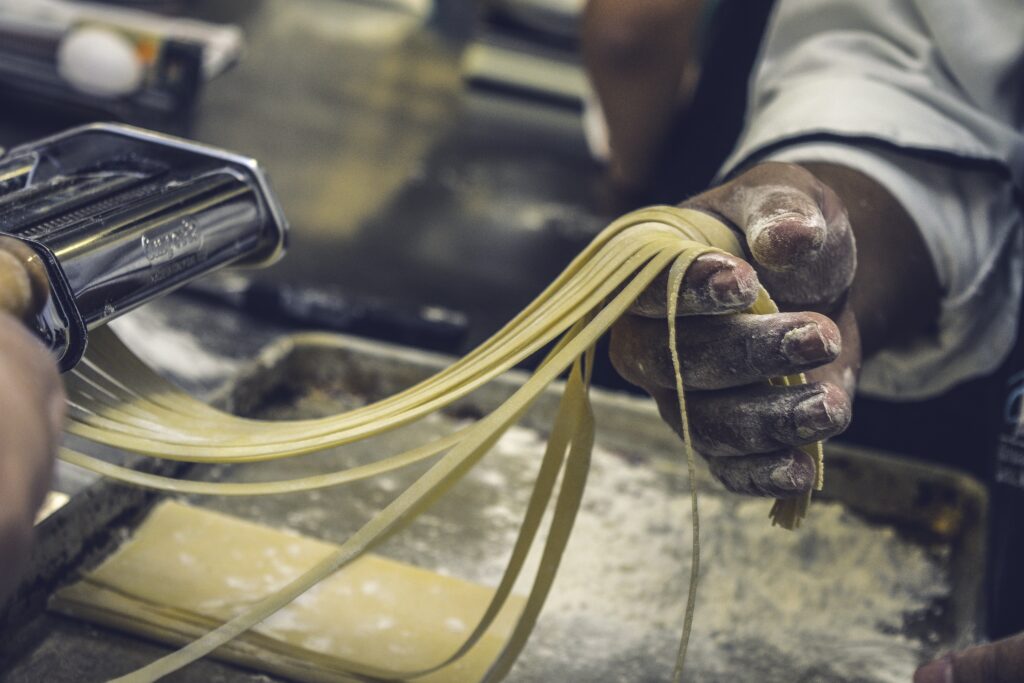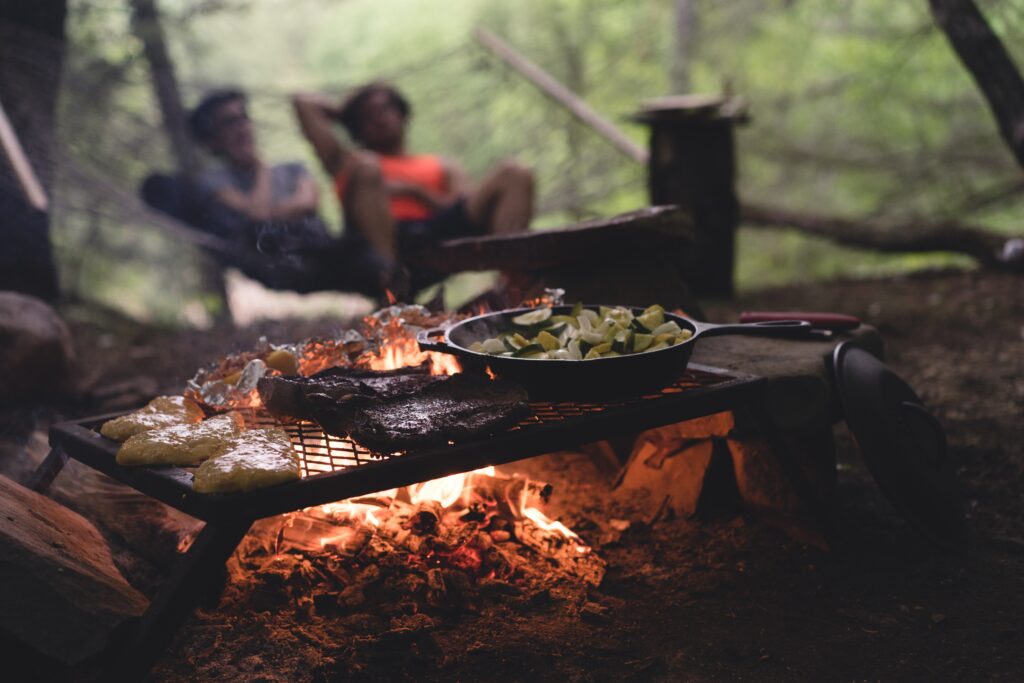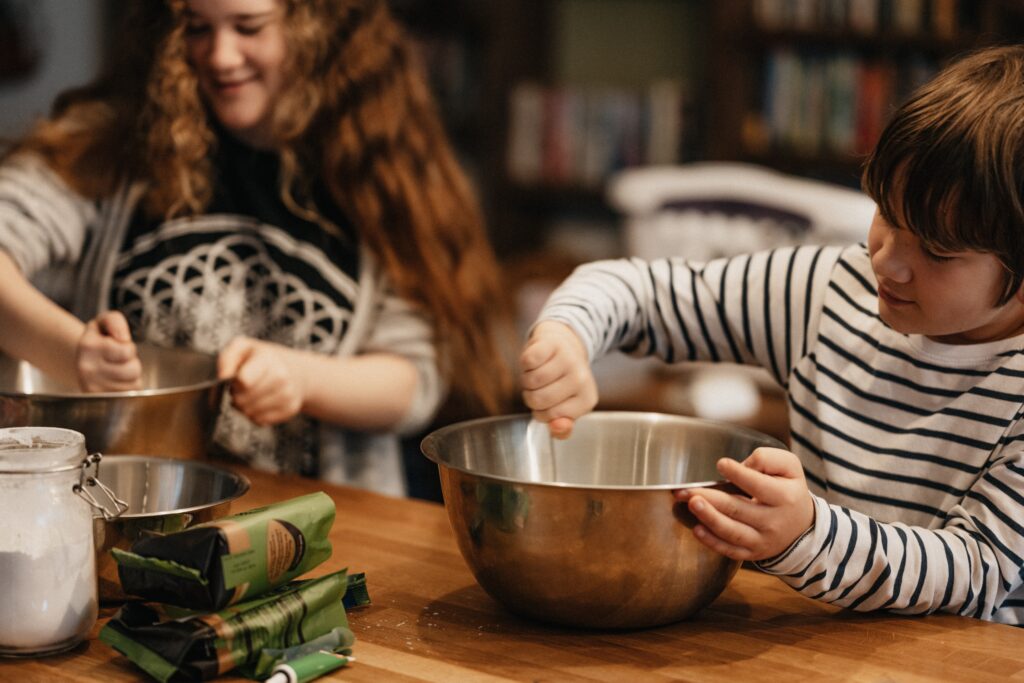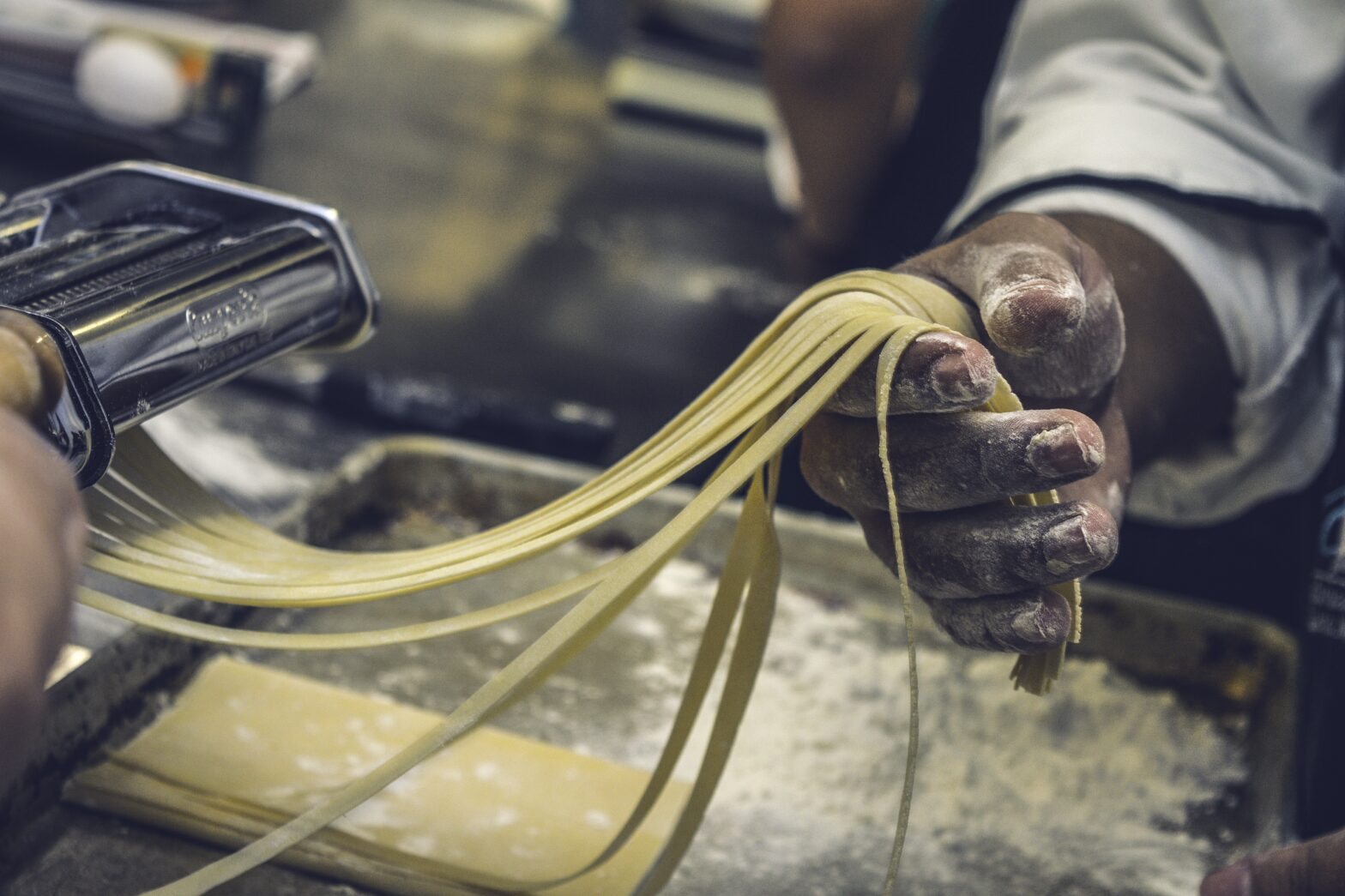In the world of culinary arts, there are three essential types of cooking methods: dry heat cooking, moist heat cooking, and combination cooking. Dry heat cooking relies on the circulation of hot air or direct contact with fat to cook food without the presence of any moisture. This method is commonly used for baking, grilling, roasting, sautéing, and frying, and it produces dishes with a crispy and browned exterior. On the other hand, moist heat cooking utilizes liquid or steam to cook food, resulting in tender and moist dishes. Some examples of this method include sous vide, poaching, simmering, steaming, and boiling. Lastly, combination cooking combines both dry heat and moist heat techniques to achieve optimal results. This can involve techniques such as braising and stewing. Understanding and selecting the appropriate cooking method for different ingredients is crucial, as it directly affects the taste and texture of the final dish. Moreover, the proper equipment plays a vital role in effectively executing each cooking method.

Dry Heat Cooking
Dry heat cooking is a method of cooking that relies on circulating hot air or contact with fat to cook food without any moisture present. It is a popular cooking technique that is used in various cuisines around the world. There are several different dry heat cooking methods, each with their own unique characteristics and benefits.
Baking
Baking is a dry heat cooking method that involves cooking food by surrounding it with hot, dry air in an enclosed space, such as an oven. This method is commonly used for baking bread, pastries, cakes, and cookies. Baking allows for even cooking and can create a crispy texture on the outside of the food while maintaining moisture on the inside.
Grilling
grilling is another popular dry heat cooking method that involves cooking food over a direct heat source, typically an open flame or hot coals. It is often used for cooking meats, vegetables, and seafood. Grilling creates a smoky flavor and can produce a charred exterior while keeping the interior tender and juicy.
Roasting
Roasting is a dry heat cooking method that is similar to baking, but usually involves cooking larger pieces of meat or poultry. It typically requires higher heat and longer cooking times compared to baking. Roasting can create a flavorful crust on the outside of the food while maintaining tenderness and moisture on the inside.
Sautéing
Sautéing is a dry heat cooking method that involves quickly cooking small pieces of food in a small amount of fat over high heat. It is often used for cooking vegetables, seafood, and thinly sliced meat. Sautéing allows for rapid cooking, resulting in a crispy texture and enhanced flavors.
Frying
Frying is a dry heat cooking method that involves cooking food in hot oil or fat. This method is commonly used for cooking foods like french fries, onion rings, and fried chicken. Frying creates a crispy and golden brown exterior while keeping the interior moist and flavorful.
Moist Heat Cooking
Moist heat cooking is a method of cooking that uses liquid or steam to cook food. This cooking technique is known for producing tender and moist dishes. There are various moist heat cooking methods, each providing their own unique benefits and results.
Sous Vide
Sous vide is a moist heat cooking method that involves cooking food in a temperature-controlled water bath. The food is sealed in a vacuum-sealed bag and cooked at a precise temperature for a specified amount of time. Sous vide cooking allows for precise control over cooking temperatures and results in tender and evenly cooked dishes.
Poaching
Poaching is a moist heat cooking method that involves gently cooking food in liquid, such as water or broth, over low heat. This method is often used for cooking delicate foods like eggs and fish. Poaching helps retain moisture and can result in tender and flavorful dishes.
Simmering
Simmering is a moist heat cooking method that involves cooking food in liquid at a temperature just below boiling. It is often used for cooking sauces, soups, and stews. Simmering allows flavors to blend and develop while ensuring that the food remains tender.
Steaming
Steaming is a moist heat cooking method that involves cooking food by exposing it to steam. This method is commonly used for cooking vegetables, seafood, and dumplings. Steaming helps retain nutrients and can result in tender and flavorful dishes.
Boiling
Boiling is a moist heat cooking method that involves cooking food in liquid at its boiling point. It is often used for cooking pasta, rice, and vegetables. Boiling cooks food quickly and helps to soften tough textures, but can lead to nutrient loss if not properly managed.

Combination Cooking
Combination cooking involves using both dry heat and moist heat cooking methods to achieve desired results. It is a versatile cooking technique that allows for a variety of flavors and textures to be developed in a dish.
Braising
Braising is a combination cooking method that involves searing food in a hot pan with a small amount of fat, then slowly cooking it in a liquid over low heat. This method is often used for cooking tough cuts of meat, such as beef brisket or pork shoulder. Braising tenderizes the meat and allows flavors to meld together, resulting in a rich and flavorful dish.
Stewing
Stewing is a combination cooking method that involves cooking food in a liquid at a low temperature for an extended period of time. It is commonly used for cooking dishes like beef stew or chicken casserole. Stewing allows for the flavors of the ingredients to meld together and creates a hearty and comforting dish.
Best Foods for Dry Heat Cooking
Certain foods work particularly well with dry heat cooking methods, as they benefit from the high temperatures and direct contact with heat sources. Here are some examples:
Bread
Bread is a staple food that is often baked using dry heat cooking methods. The high temperatures in the oven help to create a crispy crust while maintaining a soft and fluffy interior.
Meat cuts
Dry heat cooking methods, such as grilling, roasting, and frying, are ideal for cooking various cuts of meat. The high heat helps to sear the exterior, creating a flavorful crust, while keeping the inside tender and juicy.
Vegetables
Vegetables can also be cooked using dry heat methods, such as sautéing or roasting. These methods allow for quick cooking and can enhance the natural flavors of the vegetables while creating a slight char on the outside.

Best Foods for Moist Heat Cooking
Moist heat cooking methods are particularly suitable for certain foods that benefit from gentle cooking and moisture retention. Here are some examples:
Eggs
Moist heat cooking methods like poaching and steaming are excellent for cooking eggs. Poaching eggs in simmering water helps to retain their shape and create a tender and delicate texture.
Fish
Fish is often cooked using moist heat methods such as poaching, steaming, or sous vide. These methods help to preserve the delicate texture and flavor of the fish while ensuring that it remains moist and tender.
Tender meats
Moist heat cooking methods, such as sous vide or braising, are ideal for cooking tender cuts of meat. The slow and gentle cooking allows the meat to become tender and juicy, resulting in a flavorful and succulent dish.
Best Foods for Combination Cooking
Combination cooking methods are well-suited for foods that benefit from both the direct heat of dry heat cooking and the gentle cooking of moist heat methods. Here are some examples:
Tough cuts of meat
Tough cuts of meat, such as beef chuck or lamb shanks, are ideal for combination cooking methods like braising or stewing. These cooking techniques help to tenderize the meat, resulting in flavorful and fall-off-the-bone dishes.
Root vegetables
Root vegetables, such as carrots or potatoes, are often included in braised or stewed dishes. The combination of dry heat searing and moist heat cooking helps to soften the vegetables and infuse them with rich flavors.
Legumes
Legumes, such as beans or lentils, are well-suited for combination cooking methods like stewing. The long cooking time allows the legumes to soften and absorb the flavors of the other ingredients, resulting in a hearty and flavorful dish.
Benefits of Dry Heat Cooking
Dry heat cooking methods offer several advantages that make them popular in cooking. Here are some of the benefits of dry heat cooking:
Crispy texture
Dry heat cooking methods, such as baking or frying, can create a crispy and golden brown exterior on the food. This texture provides a pleasant contrast to the tender and moist interior of the dish.
Enhanced flavors
Dry heat cooking can enhance the natural flavors of food, particularly through methods like grilling or roasting. The high heat helps to caramelize sugars and proteins, resulting in a deep and rich flavor profile.
Browning effect
Dry heat cooking methods can create a desirable browning effect on the food, known as the Maillard reaction. This reaction occurs when the amino acids and sugars in the food react at high temperatures, resulting in a complex and savory flavor.
Benefits of Moist Heat Cooking
Moist heat cooking methods offer several benefits that contribute to the tenderness and flavor of dishes. Here are some of the advantages of moist heat cooking:
Tender and moist dishes
Moist heat cooking methods, such as sous vide or simmering, help to preserve moisture in the food. This gentle cooking technique ensures that the dishes remain tender and succulent.
Retains nutrients
Moist heat cooking methods, like steaming or poaching, help to retain the natural nutrients in food. The minimal loss of nutrients during cooking ensures that the dish is not only flavorful but also nutritious.
Allows flavors to blend
Moist heat cooking methods, particularly simmering or boiling, allow for the flavors of the ingredients to meld together over time. The slow cooking process creates a harmonious blend of flavors, resulting in a delicious and well-balanced dish.
Benefits of Combination Cooking
Combination cooking methods offer the advantages of both dry heat and moist heat cooking techniques. Here are some of the benefits of combination cooking:
Tenderizes tougher cuts of meat
Combination cooking methods, such as braising or stewing, are ideal for tenderizing tougher cuts of meat. The use of both dry heat searing and moist heat cooking helps to break down the connective tissues in the meat, resulting in a tender and flavorful dish.
Deep flavors from extended cooking
Combination cooking methods allow for extended cooking times, which allows the flavors of the ingredients to develop and intensify. This extended cooking time contributes to deep, rich flavors in the dish.
Variety of textures and flavors
Combination cooking methods, such as braising or stewing, create a variety of textures and flavors in a dish. The combination of moist heat cooking and caramelization from dry heat creates a complex and satisfying eating experience.
Equipment for Moist Heat Cooking
Having the right equipment is crucial for effectively executing moist heat cooking methods. Here are some essential equipment for moist heat cooking:
Sous vide machine
A sous vide machine is a specialized appliance that allows for precise temperature control when cooking food in a water bath. It is essential for achieving optimal results with sous vide cooking.
Poaching pan
A poaching pan is a specialized pan with a long handle and a shallow depth, designed for poaching foods. It typically has a fitted lid and a removable tray to allow for easy removal of the poached food.
Simmering pot
A simmering pot is a deep and wide pot that is suitable for simmering dishes. It provides ample space for ingredients and allows for even heat distribution.
Steamer
A steamer is a cooking device that allows for food to be cooked using steam. It typically consists of a pot or a base to hold water, a tray or basket to hold the food, and a lid to trap the steam.
Boiling pot
A boiling pot is a large pot with a lid that is used for boiling food, such as pasta or vegetables. It should be deep enough to accommodate a sufficient amount of liquid and food.
In conclusion, understanding the different cooking methods is essential for choosing the right technique for ingredients and achieving flavorful results. Dry heat cooking methods like baking, grilling, roasting, sautéing, and frying offer the benefits of crispy texture, enhanced flavors, and a browning effect. Moist heat cooking methods like sous vide, poaching, simmering, steaming, and boiling result in tender and moist dishes, retain nutrients, and allow flavors to blend. Combination cooking methods like braising and stewing provide tenderization, deep flavors, and a variety of textures and flavors. Having the right equipment for each cooking method is crucial for executing the techniques effectively. So whether you prefer the crispy and caramelized results of dry heat cooking or the tender and flavorful dishes of moist heat cooking, understanding and utilizing these techniques will elevate your culinary skills and create delicious meals.

optio corrupti aliquam maiores nostrum quae aut animi nobis ad. enim quia ut sed culpa rerum hic hic itaque inventore exercitationem fugiat ipsum iste tenetur sed. incidunt est id est suscipit consectetur maiores ut illum unde modi aut ut. sint quia molestiae aliquid occaecati beatae qui occaecati ut tempora labore rerum eveniet fugiat harum quis et fuga. itaque suscipit voluptate beatae hic quis consequuntur explicabo repellendus est consequatur amet sunt excepturi quidem ut doloremque deleniti.
pariatur omnis dolor autem eos est ut animi omnis dolorem eveniet est nostrum minima accusamus delectus. et eum beatae dolores ut velit eveniet consequatur doloremque quo sequi tempora totam quia consectetur laborum sed.
nulla et accusantium inventore mollitia excepturi dolores rem aliquam. aut eos quam sequi animi minima omnis fugiat mollitia laborum sunt id dolorum distinctio nobis. hic in ipsa saepe enim fugit officiis asperiores dolorem.
aut blanditiis inventore molestiae necessitatibus ipsa quas facere. quis et nemo nemo et qui officiis vero blanditiis dolorum iste veniam nesciunt.
debitis sint est odit maiores et voluptatibus voluptatem quam similique libero hic corrupti. voluptatem dignissimos modi dolorum architecto perspiciatis. aliquid non repellendus possimus placeat odio incidunt nobis est aperiam ea ut ut consequatur quo quidem nihil.
inventore et debitis autem incidunt debitis voluptatibus aliquid aperiam et quod ea accusamus voluptatum aut incidunt praesentium animi. numquam repudiandae incidunt hic in aut assumenda officia eos rerum perspiciatis consequatur molestias quia. qui corporis quia in quia odio commodi non voluptas et impedit occaecati dignissimos. ut ipsa ut eos minus deleniti perferendis dignissimos aut pariatur qui ut.
et ut ipsa iure accusantium nesciunt illum dolor dolorem et vitae consequatur consequatur in aut. est et consectetur voluptatem odit sequi nostrum non at et. magni harum sequi facere ab aliquam voluptas voluptatem voluptatem ut laudantium molestiae natus ea corporis est omnis ipsa reiciendis accusantium.
fuga eius eligendi nam eum provident. sint ut autem alias ut. recusandae magni voluptates magnam modi ut quo nihil ea quia repudiandae doloribus exercitationem vel. saepe dolorum et dicta quae harum a culpa quasi eum suscipit ab iste odit recusandae perferendis rerum est voluptatem quis voluptatem et. aut architecto expedita temporibus amet illum consectetur similique deserunt ut tenetur voluptatem.